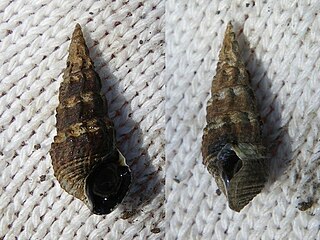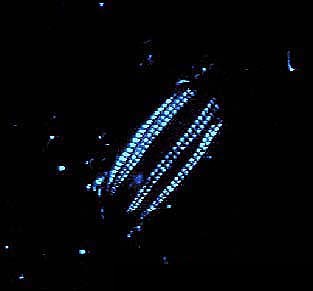
Heteroconchia is a taxonomic infraclass of diverse bivalve molluscs, belonging to the subclass Autobranchia.

Tegula is a genus of small to medium-sized sea snails, marine gastropod molluscs in the family Tegulidae.

Neritidae, common name the nerites, is a taxonomic family of small to medium-sized saltwater and freshwater snails which have a gill and a distinctive operculum.

Carcharias is a genus of mackerel sharks belonging to the family Odontaspididae. Once bearing many prehistoric species, all have gone extinct with the exception of the critically endangered sand tiger shark.

Batillaria is a genus of small salt marsh or mudflat snails, marine gastropod mollusks in the family Batillariidae, the horn snails.

Verticordiidae is a family of benthic marine bivalves in the superorder Anomalodesmata. These clams range from 2 - 200 millimeters in length and are mainly found in coastal waters surrounding Australia and the Americas, though a few species within this family such as Haliris mediopacifica are found in the middle of the ocean. Verticordiidae is known for being a family of septibranchs, or predatory bivalves, rather than filter feeders. Clams dig vertical burrows in substrate and use papillae around the edges of their inhalant siphons to detect microscopic prey. Some clams in this family, specifically in the genus Trigonulina, have distinct extended circular formations on their shells.

Lottiidae is a family of sea snails, specifically true limpets, marine gastropod mollusks in the superfamily Lottioidea and the clade Patellogastropoda.
The World Register of Marine Species (WoRMS) is a taxonomic database that aims to provide an authoritative and comprehensive list of names of marine organisms.

Stellaria is a genus of large sea snails, marine gastropod mollusks in the family Xenophoridae, the carrier shells.

Bolinopsidae is a family of ctenophores.
Paul Russell Krutak was an eminent American micropaleontologist. He received his Bachelor's and master's degrees in Geology at Louisiana State University (LSU) in Baton Rouge, as well as a Ph.D. in Geology at LSU in 1963. His dissertation was entitled Structure, Stratigraphy, and Provincial Relationships of Sierra de la Gavia, Coahuila, Mexico.
Lyria (Plicolyria) is a subgenus of sea snail, a marine gastropod mollusk in the family Volutidae.
Haliris is a genus of the class Bivalvia of the family Verticordiidae.

Euplokamis is a genus of ctenophores, or comb jellies, belonging to the monotypic family Euplokamididae. It shares the common name sea gooseberry with species of the genus Pleurobrachia. Despite living for hundreds of millions of years in marine environments, there is minimal research regarding Euplokamis, because they are uncommon. Research on the evolution of the basic body structures of diploblastic metazoans revealed that there are four major phyla, including the Ctenophores. Although the morphology of Euplokamis often resembles the medusa stage of Cnidarians, their eight rows of combs are one distinguishing feature that led to the official classification of Ctenophores. After being originally described by Chun (1879), the family Euplokamididae was expanded by Mills (1987) due to the discovery of a new species, Euplokamis dunlapae. Further research indicated that Euplokamis should be identified from Mertensiidae due to the rows of combs and some compression. They may also be distinguished from the genus Pleurobrachia due to their more elongated shape. Additionally, various adaptations of Euplokamis have been observed such as the use of tentacles for movement/feeding, a complex nervous system, and bioluminescent capabilities. Other characteristics including a defined mesoderm, lack of stinging cells, developmental differences, and symmetry supported the reclassification of these organisms.
HalicardiaDall, 1895 is a genus of bivalves in the family Verticordiidae.
Vertambitus is a genus of the bivalves in the family Verticordiidae.
Spinosipella is a genus of small carnivorous bivalves in the family Verticordiidae.

Euplokamis stationis is a marine species of ctenophores. It was named after a zoological station in Naples, Italy.
Euplokamis evansae is a marine species of ctenophore.










